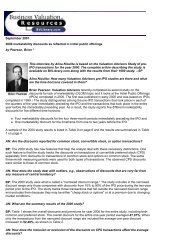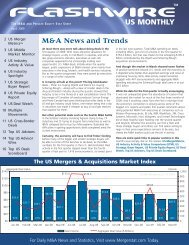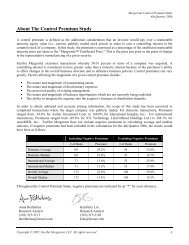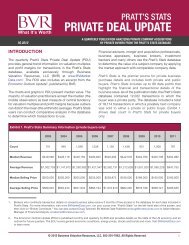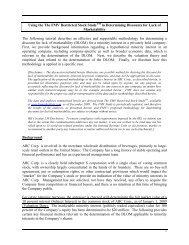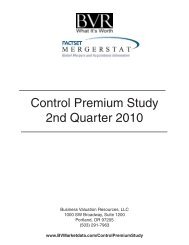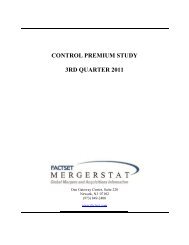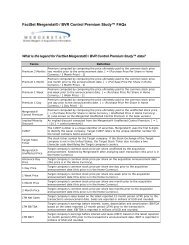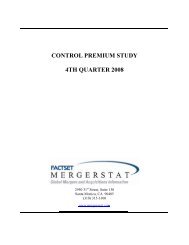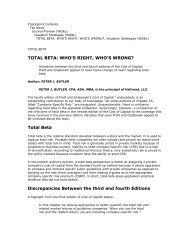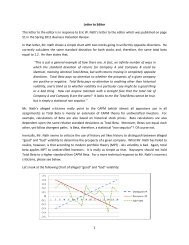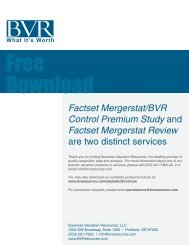Total Beta or Beta? Peter J. Butler, CFA, ASA - BVMarketData
Total Beta or Beta? Peter J. Butler, CFA, ASA - BVMarketData
Total Beta or Beta? Peter J. Butler, CFA, ASA - BVMarketData
Create successful ePaper yourself
Turn your PDF publications into a flip-book with our unique Google optimized e-Paper software.
<strong>Total</strong> <strong>Beta</strong> <strong>or</strong> <strong>Beta</strong><br />
<strong>Peter</strong> J. <strong>Butler</strong>, <strong>CFA</strong>, <strong>ASA</strong><br />
While it does not necessarily have to be one <strong>or</strong> the other, this was the primary question facing<br />
panelists and the audience at the <strong>ASA</strong> Advanced BV Conference in Boston on October 20, 2009.<br />
In the interest of full disclosure, I am a strong proponent of total beta as the <strong>Butler</strong> Pinkerton<br />
Calculat<strong>or</strong> (BPC) relies upon it f<strong>or</strong> its underlying the<strong>or</strong>y and calculations (Note: I will add my<br />
own commentary in italics when commenting upon other panelists’ points).<br />
With that out of the way, the following is a synopsis of the very unique debate (in <strong>or</strong>der of<br />
panelist appearance) held in Boston in front of approximately 350 appraisers.<br />
First as a reminder, total beta is equivalently: <strong>Beta</strong>/r <strong>or</strong> σ s /σ m where r is the c<strong>or</strong>relation coefficient<br />
between a stock and the market andσrepresents the standard deviation of either the stock <strong>or</strong> the<br />
market.<br />
Dr. Chris Tofalis: “<strong>Total</strong> <strong>Beta</strong>: Estimating <strong>Beta</strong> Symmetricaly”<br />
After taking the audience through some statistical concepts, Profess<strong>or</strong> Tofallis concluded that<br />
<strong>or</strong>dinary beta confounds c<strong>or</strong>elation (r) with the relative volatility (σ s /σ m ) in the following<br />
equation:<br />
<strong>Beta</strong> = rσ s /σ m<br />
In other w<strong>or</strong>ds, if r is close to zero, a very volatile stock (with a high total beta and high total<br />
risk) will have a beta (and systematic risk) close to zero.<br />
Profes<strong>or</strong> Tofalis then pointed out beta’s instability and cited research that indicated that a<br />
stock’s c<strong>or</strong>elation (r) with the market is (generaly) the most unstable statistic withinbeta. He<br />
then mentioned that since total beta does not contain the c<strong>or</strong>relation (r), it should be m<strong>or</strong>e stable<br />
over time. (This is one big advantage of total beta over beta. The BPC calculates both total<br />
beta and beta. In an attempt to deal with the volatility of beta, I recommend running the BPC<br />
(<strong>or</strong> doing the calculations yourself) f<strong>or</strong> all five-trading days of the week f<strong>or</strong> the most appropriate<br />
look-back period This will allow you to (generally) see the volatility in beta and the relative<br />
stability in total beta).<br />
Profess<strong>or</strong> Tofallis concluded his presentation with the comment that conventional beta is not a<br />
robust statistic–a conclusion which all panelists agreed with. He also indicated that he wanted<br />
to perf<strong>or</strong>m additional research on the relative stability between beta and total beta. (I<br />
subsequently invited Profess<strong>or</strong> Tofallis to perf<strong>or</strong>m this research using the BPC, if he so desires).<br />
1
Mr.<strong>Peter</strong> <strong>Butler</strong>: “The <strong>Butler</strong> Pinkerton Calculat<strong>or</strong>: The Choice”<br />
I commented upon traditional fact<strong>or</strong> models and their lack of empirical data f<strong>or</strong> companyspecific<br />
risk (CSR). I also cited various court cases which indicate that judges, f<strong>or</strong> lack of a<br />
beter w<strong>or</strong>d, are tired of gueses used by appraisers to “bring their final results into line with their<br />
clients’ objectives, when other valuation inputs fail to do the trick”.<br />
I then keyed in on the total cost of equity (TCOE) equation developed by Profess<strong>or</strong> Damodaran:<br />
TCOE = risk-free rate + <strong>Total</strong> <strong>Beta</strong>*Equity Risk Premium<br />
(Note: Mr. Larry Kasper has a maj<strong>or</strong> problem with total beta in this equation). When referring<br />
to this equation, I cited five other PhDs (as well as numerous appraisers and a p<strong>or</strong>tion of a<br />
Harvard Business School (HBS) case study) who have no problems using total beta in this<br />
equation f<strong>or</strong> the analysis of private companies. (Note: I also cited two investment banks’ usage<br />
of total beta when calculating f<strong>or</strong>eign countries’ equity risk premiums(ERP). Mr. Roger<br />
Grabowski took issue with this claim. However, I also attended the AICPA BV Conference in<br />
San Francisco in November and heard Profess<strong>or</strong> Damodaran refer to Goldman Sachs’use of<br />
total beta when determining a f<strong>or</strong>eign country’s ERPin one of his slides).<br />
I cited sources f<strong>or</strong> peer-review (AICPA textbook, PPC textbook, CCH textbook, NACVA and its<br />
Current Update in Valuations, the HBS case study, numerous independent<br />
end<strong>or</strong>sements/testimonials, including by some holding doct<strong>or</strong>ates in finance, the Sharpe Ratio<br />
(Refuted by Mr. Grabowski, but used by Profess<strong>or</strong> Meulbroek, Covrig and McConaughy in their<br />
derivation of total beta. In fairness to Mr. Grabowski, he cites Dr. Sharpe himself to refute the<br />
Sharpe ratio–I will touch upon this below), investment banks (Refuted by Mr. Grabowski.<br />
However, there seems to be conflicting inf<strong>or</strong>mation about this as noted above)).<br />
I concluded my presentation by referring to its sub-title, “The Choice”. The choice is between<br />
empirical data f<strong>or</strong> CSR and TCOE (using total beta) and no data f<strong>or</strong> CSR (using completely<br />
subjective fact<strong>or</strong> models). I cautioned the audience to make the choice wisely.<br />
Larry Kasper: “Anomalous Findings from the <strong>Butler</strong> Pinkerton Modelf<strong>or</strong> Company<br />
Specific Risk Premiums–TCOE, <strong>Total</strong> <strong>Beta</strong>, Diversification Discount”<br />
(Mr. Kasper had 74 slides f<strong>or</strong> a 30 minute presentation.<br />
points).<br />
Theref<strong>or</strong>e, I will key in on maj<strong>or</strong><br />
Mr. Kasper started his presentation with the following comments: If total beta is wrong, then:<br />
TCOE is wrong<br />
<strong>Butler</strong> Pinkerton Model is wrong<br />
Diversification discount is wrong<br />
2
Mr. Kasper then used most of his time trying to prove that total beta is wrong. (I encourage all<br />
to take a look at his slides. Below, I will show how he failed in his mission).<br />
(The issue which is readily apparent, however, in his writings as well as in this debate is Mr.<br />
Kasper has somehow believed that I have called f<strong>or</strong> total beta (total risk) and the BPC to be used<br />
f<strong>or</strong> the investment analysis of publicly-traded stocks. We all know that CSR is at least partially<br />
diversified away f<strong>or</strong> public stocks, so it makes no sense that we would promote total beta (total<br />
risk) in this manner–yet this is what Mr. Kasper would have you believe. Mr. Kasper actually<br />
thought that (as two <strong>CFA</strong>s) we were claiming that a stock will have a different rate of return<br />
depending on if a diversified invest<strong>or</strong> <strong>or</strong> an undiversified invest<strong>or</strong> owned the stock.<br />
We have only promoted total beta as a proxy f<strong>or</strong> private companies where total risk is either<br />
priced <strong>or</strong>, at a minimum, some level of CSR is priced. In other w<strong>or</strong>ds, Mr. Kasper believes that<br />
total beta violates financial the<strong>or</strong>y. It does–BUT only f<strong>or</strong> publicly-traded stock where stocks<br />
are priced as part of p<strong>or</strong>tfolios; <strong>Total</strong> beta does not violate financial the<strong>or</strong>y, however, f<strong>or</strong> private<br />
companies where CSR is priced on some level).<br />
Profes<strong>or</strong> Damodaran: “Diversification, Cost of Equity and Value”<br />
Profes<strong>or</strong>’s Damodaran, in his only direct commentary on Mr. Kasper’s presentation, made the<br />
following statement related to the comment that the <strong>Butler</strong> Pinkerton Calculat<strong>or</strong> and/<strong>or</strong> total beta<br />
could not withstand a serious Daubert Challenge (at a 95% confidence level):<br />
This is valuation. I don’t even have 95% confidence regarding the change in my<br />
pocket…<strong>or</strong> w<strong>or</strong>ds to that efect.<br />
(Out of curiosity, does anyone think that the subjective fact<strong>or</strong> models provide 95% confidence)<br />
Profess<strong>or</strong> Damodaran then described the mean-variance framew<strong>or</strong>k (the background f<strong>or</strong> the<br />
CAPM) and mentioned that the risk of an investment is not the risk of it standing alone, but the<br />
risk that it adds to your overall investment p<strong>or</strong>tfolio (as calculated by beta). Thus, in this CAPM<br />
w<strong>or</strong>ld, the expected return of an individual investment is equal to:<br />
Expected return = R f + beta*ERP<br />
But, “Rebels” exist who violate the CAPM w<strong>or</strong>ld.These rebels, instead of choosing to invest in<br />
the market p<strong>or</strong>tfolio (a completely diversified p<strong>or</strong>tfolio) choose to invest all of their wealth (<strong>or</strong> at<br />
least a sizable p<strong>or</strong>tion of their net w<strong>or</strong>th) in a private business. If the completely undiversified<br />
invest<strong>or</strong> wants a return comparable to what he <strong>or</strong> she would make as a diversified invest<strong>or</strong>, then<br />
the expected return is equal to:<br />
Expected return = R f + total beta*ERP<br />
Profess<strong>or</strong> Damodaran brought out imp<strong>or</strong>tant implications of this equation:<br />
3
1) When selling a private business <strong>or</strong> asset, the best potential buyer, other things being<br />
equal, will be a diversified invest<strong>or</strong> <strong>or</strong> an entity with diversified invest<strong>or</strong>s (a publicly<br />
traded firm).<br />
2) Private business owners who are fully invested in their own businesses are holding onto<br />
these businesses at a discount, especially if going public <strong>or</strong> selling to a publicly-traded<br />
company is an option (as diversified invest<strong>or</strong>s will pay a higher price f<strong>or</strong> the same asset<br />
as an undiversified invest<strong>or</strong> since the diversified invest<strong>or</strong> can shed the inherent<br />
unsystematic risk).<br />
3) <strong>Total</strong> beta should provide little explanat<strong>or</strong>y power f<strong>or</strong> expected returns of publicly-traded<br />
firms, especially those that are widely held by institutions and have large market caps. (I<br />
have always mentioned this in my presentations and in writing, contrary to Mr. Kasper’s<br />
assertions).<br />
4) <strong>Total</strong> beta is not the appropriate measure of risk if an asset is being valued f<strong>or</strong> a potential<br />
buyer who is mostly diversified. (Note: When you placed a CSRP on a private company<br />
in the past, how did you analyze the relative diversification, <strong>or</strong> not, of the likely pool of<br />
buyers While total beta does capture maximum TCOEs and CSRPs, these are data<br />
points we have never had bef<strong>or</strong>e. <strong>Total</strong> beta allows one to better think through these<br />
issues).<br />
Profess<strong>or</strong> Damodaran then noted the problematic issues related to the build-up model (BUM)–<br />
the typical approach used by many, if not most, appraisers.<br />
The profes<strong>or</strong> caled the BUM a “recipe f<strong>or</strong> disaster” f<strong>or</strong> the folowing reasons:<br />
1) Dependence on hist<strong>or</strong>ical data (Note: recently the profess<strong>or</strong> added a feature to his<br />
website, www.damodaran.com, which calculates the f<strong>or</strong>ward-looking ERP (updated<br />
monthly)).<br />
2) Double counting <strong>or</strong> triple counting risk and/<strong>or</strong> internal consistencies (F<strong>or</strong> example, there<br />
may be a liquidity premium in some (<strong>or</strong> all) industry risk premiums (IRPs) if small,<br />
lightly/inefficiently traded companies are included; it is likely there is a liquidity<br />
premium in the “size premium” f<strong>or</strong> smaler deciles as these are the companies that are<br />
lightly and/<strong>or</strong> inefficiently traded; Since both size premiums and IRPs calculate expected<br />
returns from beta and compare it to actual returns, these two metrics may be doublecounting<br />
risk in some fashion; it is next to impossible to separate size risk from CSR;<br />
Potential f<strong>or</strong> questionable guidelines in the IRP; and the fact that the BUM does not<br />
account f<strong>or</strong> leverage in the IRP such as how betas and total betas can be adjusted f<strong>or</strong><br />
4
leverage. Of course, after you get through the gauntlet above, you still have to<br />
completely guess at CSR).<br />
Profess<strong>or</strong> Damodaran ended his presentation with the comment that the diversification discount<br />
is separate from the illiquidity discount. In other w<strong>or</strong>ds, it is perfectly logical to use a higher<br />
discount rate to capture the absence of diversification and also apply an illiquidity discount to<br />
value. The same cannot be said of build-up models. (Note: the BPC allows appraisers to see the<br />
average daily rep<strong>or</strong>ted trading volume f<strong>or</strong> each week so appraisers can make the (subjective)<br />
determination if there is a liquidity premium in the pricing. If the stock does trade in an<br />
inefficient market (i.e., may have a liquidity premium), then the appraiser may want to exclude<br />
the guideline from further consideration).<br />
Profess<strong>or</strong> Tofallis essentially passed on his turn f<strong>or</strong> rebuttal (Note: Profes<strong>or</strong> Tofalis’<br />
presentation was not controversial f<strong>or</strong> any of the panelists).<br />
Rebuttal from<strong>Peter</strong> <strong>Butler</strong>: “The <strong>Butler</strong> Pinkerton Calculat<strong>or</strong>: Stil (by far) the Best<br />
Choice”<br />
After hearing Mr. Kasper’s presentation, I keyed in on a few points I believe were taken out of<br />
context. Mr. Kasper cited Dr. Sharpe’s seminal paper from 1964 and puled the folowing quote:<br />
Thus far nothing has been said about such a relationship f<strong>or</strong> individual assets.<br />
Typicaly the ER, σR values asociated with single asets wil lie above the capital<br />
market line, reflecting the inefficiency of undiversified holdings. M<strong>or</strong>eover, such<br />
points may be scattered throughout the feasible region, with no consistent<br />
relationship between their expected return and total risk (σR). However, there<br />
will be a consistent relationship between their expected returns and what might be<br />
best called systematic risk as we now show.<br />
Mr. Kasper implied that the bolded statement above was a critical blow to total beta since total<br />
beta captures total risk, <strong>or</strong>σ, and develops a consistent relationship between expected return and<br />
risk.<br />
However, of course, there is no relationship between expected return of an individual stock and<br />
its total risk–in a p<strong>or</strong>tfolio. In the quote above, Dr. Sharpe was setting the stage f<strong>or</strong> beta and the<br />
CAPM (please see the last sentence) where a stock’s contribution of risk to a wel-diversified<br />
p<strong>or</strong>tfolio is its beta (systematic risk) and its expected stock return is based on the CAPM. Private<br />
companies, on the other hand, have either completely priced CSR and, theref<strong>or</strong>e, total risk, <strong>or</strong> at<br />
least partially priced CSR. Theref<strong>or</strong>e, total beta reference points are useful in making<br />
appropriate determinations of the cost of capital f<strong>or</strong> private companies.<br />
I also commented upon another quote taken out of context by Mr. Kasper from the 4 th edition of<br />
the Brealey and Myers textbook:<br />
5
No one has shown that invest<strong>or</strong>s have paid a premium f<strong>or</strong> diversified<br />
firms…implying that there is no diversification discount.<br />
Mr. Kasper confused diversified firms with diversified invest<strong>or</strong>s. He failed to provide the<br />
following background in an attempt to show that various PhDs in finance, as well as Pinkerton<br />
and myself, misunderstand financial the<strong>or</strong>y. In my rebuttal, I quoted the entire quote from the 5 th<br />
edition:<br />
What about diversification as an end in itself It is obvious that diversification<br />
reduces risk. Isn’t that a gain from merging The trouble with this argument is<br />
that diversification is easier and cheaper f<strong>or</strong> the stockholder than f<strong>or</strong> the<br />
c<strong>or</strong>p<strong>or</strong>ation. No one has shown that invest<strong>or</strong>s have paid a premium f<strong>or</strong><br />
diversified firms.<br />
This quote relates to mergers of companies and their (inappropriate) quest to diversify (nonstrategically)<br />
since public stock invest<strong>or</strong>s can do it much easier. It has nothing to do with private<br />
firms where often times the buyer pool is (relatively) undiversified. Public stock invest<strong>or</strong>s can<br />
obtain diversification much easier than c<strong>or</strong>p<strong>or</strong>ations–<strong>or</strong> f<strong>or</strong> that matter, the private business<br />
owner <strong>or</strong> likely pool of potential private business owners.<br />
The diversified public stock invest<strong>or</strong> will crowd out the undiversified public stock invest<strong>or</strong> and<br />
be willing to pay a higher price (since he <strong>or</strong> she is not exposed to as much of the individual<br />
company’s risk) and earn a lower return than an undiversified public invest<strong>or</strong> would require.<br />
Obviously, the seller, if economically rational, will accept the higher bid. In other w<strong>or</strong>ds, if there<br />
are undiversified invest<strong>or</strong>s in the public markets, they do not set the prices of stocks. Thus, Mr.<br />
Kasper’s specious argument that I (as wel as numerous PhDs):<br />
have an unsupp<strong>or</strong>ted and unfounded belief that private owners have higher costs<br />
of capital than undiversified public invest<strong>or</strong>s… is without merit.<br />
Stated another way, undiversified public invest<strong>or</strong>s are price-takers and not price-setters and,<br />
theref<strong>or</strong>e, not imp<strong>or</strong>tant to the pricing of (efficiently traded) public stocks. Undiversified (<strong>or</strong> not<br />
completely diversified) private buyers set the price of private firms, in contrast to diversified<br />
public invest<strong>or</strong>s. This esentialy refutes al of Mr. Kasper’s isues with total beta. Thus, he<br />
has not proven total beta wrong! Theref<strong>or</strong>e, contrary to his false assertion, there is a need<br />
to rescale beta to total beta (<strong>Beta</strong>/r <strong>or</strong> σ s /σ m ) to use as a proxy f<strong>or</strong> private companies.<br />
I then asked appraisers if they were on the left-side <strong>or</strong> the “right” side of the folowing<br />
observations related to beta (left-hand side) and total beta (right-hand side):<br />
C<strong>or</strong>related volatility (rσ s /σ m ) v. Relative volatility (σ s /σ m )<br />
Covariance v. Standard deviation<br />
Well-diversified p<strong>or</strong>tfolio v. Stand-alone asset<br />
6
P<strong>or</strong>tfolio managers v. Appraisers<br />
Partial risk v. <strong>Total</strong> risk<br />
No empirical data v. Empirical data<br />
I have made my choice: I am on the right-side.<br />
(relatively speaking)).<br />
(I also could have added: Unstable v. Stable<br />
Mr. Kasper’s Response:<br />
Mr. Kasper stated that he viewed the statement from Dr. Sharpe’s paper accurately (<strong>or</strong> w<strong>or</strong>ds to<br />
that effect). (F<strong>or</strong> what it is w<strong>or</strong>th, I encourage everyone to read Dr. Sharpe’s paper: Wiliam F.<br />
Sharpe (1964), “Capital aset prices: A The<strong>or</strong>y of market equilibrium under conditions of risk,”<br />
Journal of Finance, 19 (3)).<br />
Panel Discussion:<br />
One of the maj<strong>or</strong> points discussed was the following:<br />
<strong>Total</strong> beta violates the CAPM (By definition, since total beta is used in the CAPM in<br />
place of beta, it naturally violates the CAPM. However, the size premium and the CSR<br />
also violate the CAPM. Most imp<strong>or</strong>tantly, the mere existence of private companies<br />
violates the CAPM. If a private business owner does not own the market p<strong>or</strong>tfolio (a<br />
completely diversified p<strong>or</strong>tfolio) then he <strong>or</strong> she has violated the CAPM. <strong>Total</strong> beta<br />
better models this violation).<br />
Mr. Roger Grabowski: “<strong>Total</strong> <strong>Beta</strong> v. <strong>Beta</strong> and Isues with the <strong>Butler</strong> Pinkerton Model”<br />
Mr. Grabowski ended the debate by changing his role from moderat<strong>or</strong> to an unchallenged<br />
panelist–unchallenged in the fact that no other panelist saw his slides bef<strong>or</strong>e he delivered them<br />
to the audience. I will respond to his observations here, instead of having the opp<strong>or</strong>tunity in<br />
Boston, which I would have appreciated.<br />
Investment banks do not use total beta to develop f<strong>or</strong>eign country ERPs (I have already<br />
commented upon this. I will leave it up to the reader to decide f<strong>or</strong> himself/herself).<br />
BPM is based on the premise that most owners of private businesses are undiversified,<br />
theref<strong>or</strong>e the cost of capital of the private business should include that extra amount due<br />
to the owner being undiversified. This leads to the unreasonable position that there are<br />
at least two costs of capital f<strong>or</strong> a business–the cost of capital f<strong>or</strong> invest<strong>or</strong>s that comprise<br />
the pool of likely buyers and the current owner. (It has always been about the pool of<br />
likely buyers f<strong>or</strong> private companies. Sometimes, however, the current owner may be a<br />
good proxy to gauge the diversification, <strong>or</strong> lack thereof, of the pool of likely buyers.<br />
Along this line of thinking, I asked the Boston audience if anyone had ever asked to see<br />
7
their busines owner’s p<strong>or</strong>tfolio statements when valuing his/her private company. As<br />
far as I could see, no one raised their hand. I believe this diversification issue has<br />
(generally) been given very little thought in our industry. My hunch is that when we as<br />
an industry have placed a CSR on a company we have (generally) viewed it as a standalone<br />
asset).<br />
<br />
<br />
No one uses TCOE = R f + <strong>Total</strong> beta*ERP (We all know that CSR is<br />
not completely priced f<strong>or</strong> publicly traded stocks – otherwise there would be a<br />
relationship between σ and expected return. Thus, why would any academic/researcher<br />
ever consider using TCOE to analyze publicly-traded stock investments)<br />
<strong>Beta</strong> estimates using “look-back” methods are subject to estimation<br />
err<strong>or</strong>. Thus, CSRP estimates derived from beta estimates are also subject to estimation<br />
err<strong>or</strong>. (True; I agree. What is not subject to estimation err<strong>or</strong> in the w<strong>or</strong>ld of<br />
finance/valuation The BPC, however, alerts the appraiser to this issue. Appraisers can<br />
run the Calculat<strong>or</strong> (<strong>or</strong> perf<strong>or</strong>m the calculations yourself) f<strong>or</strong> all five days of the trading<br />
week to gain a much better handle on this issue than solely relying upon printed sources<br />
of capital which ign<strong>or</strong>e the sensitivity. M<strong>or</strong>eover as pointed out above, total beta, being<br />
generally m<strong>or</strong>e stable than beta, is relatively immune to this estimation err<strong>or</strong> criticism).<br />
<br />
<br />
Profes<strong>or</strong> Sharpe states: “The Sharpe Ratio does not cover cases in<br />
which one investment return is involved”. (Why would it Individual assets–not part<br />
of a p<strong>or</strong>tfolio - violate the CAPM).<br />
Everyone would like a better method of estimating CSRPs–but is<br />
BPM the method<br />
“Say it ain’t so, Joe!”<br />
(By using the above quote, Mr. Grabowski believes that the BPM is not the method. I<br />
believe, however, that Mr. Grabowski is mistaken if he believes that total beta and the<br />
BPC are inferi<strong>or</strong> to completely guessing at CSR. That, in a nutshell, is what the BPC is<br />
up against–a complete guess. Given this threshold, I am quite surprised at the intensity<br />
of the misinf<strong>or</strong>med criticism of total beta).<br />
New Commentary by <strong>Peter</strong> <strong>Butler</strong>:<br />
Since Shoeless Joe Jackson was somehow brought into the debate from the grave, I end this<br />
paper with the following (adapted)quote from “A Field of Dreams” –a baseball movie which<br />
f<strong>or</strong>tuitously also “quotes” shoeles Joe:<br />
8
“If you build it, they wil come”<br />
While we have built the Calculat<strong>or</strong> f<strong>or</strong> ease of use and transparency, you do not have to use it. I<br />
do, however, recommend that you use the the<strong>or</strong>y behind total beta (while not throwing out all of<br />
your other methods. It is a good idea, however, to carefully consider all of the issues related to<br />
the BUM pointed out above) to build your own“field” –a field that eliminates some of the<br />
subjectivity in developing CSRPs and, theref<strong>or</strong>e, TCOEs f<strong>or</strong> private companies.<br />
9



